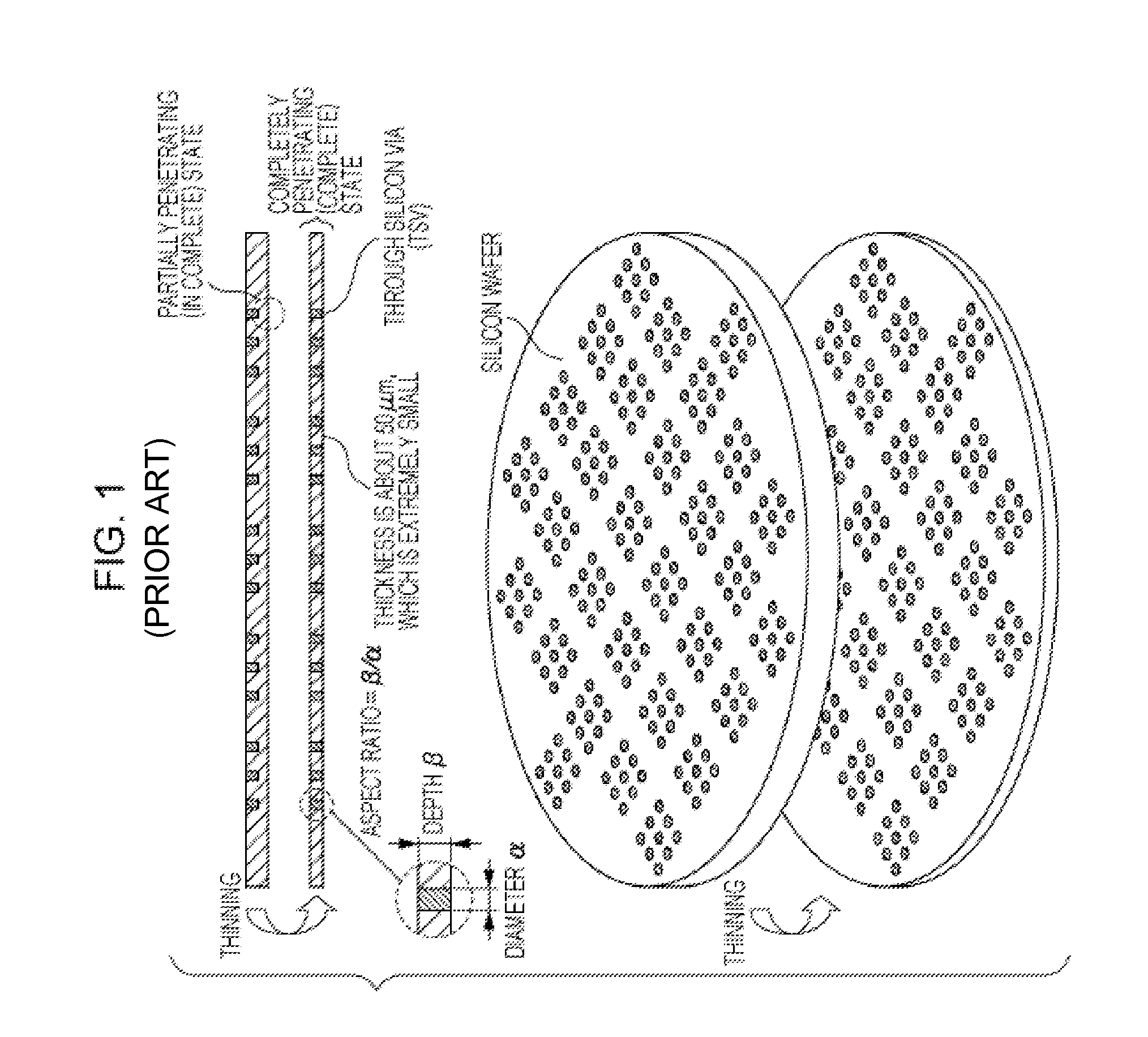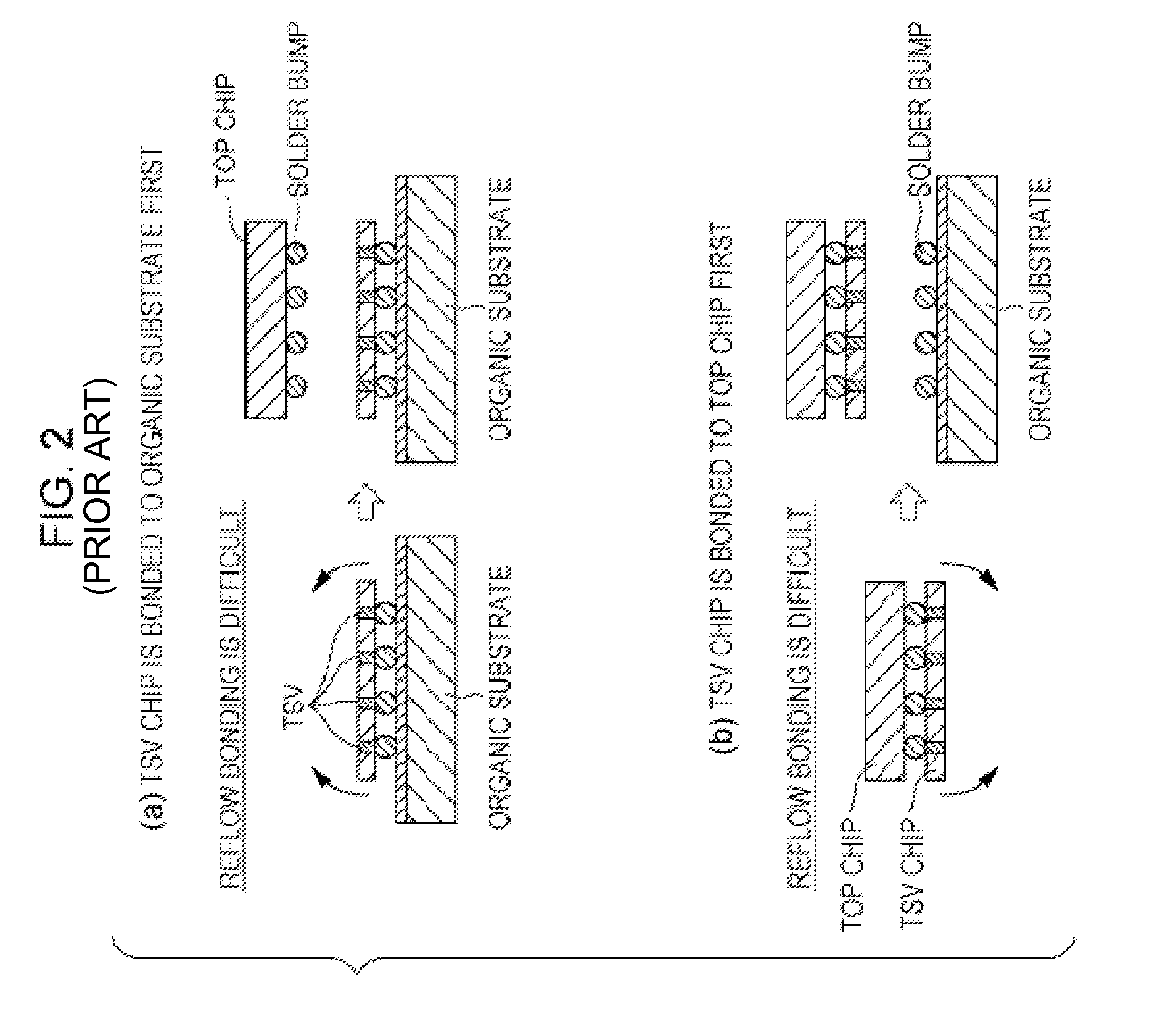Prevention of warping during handling of chip-on-wafer
- Summary
- Abstract
- Description
- Claims
- Application Information
AI Technical Summary
Benefits of technology
Problems solved by technology
Method used
Image
Examples
first embodiment
[0023]FIG. 3 illustrates a process according to the present invention. In step A1, a silicon wafer in which TSVs do not extend to one of top and bottom surfaces of the silicon wafer and are in a partially penetrating, or incomplete, state is prepared. The wafer in this state can be referred to as a “TSV wafer (before thinning)” or a “wafer before thinning”.
[0024]A plurality of chips, which have already been tested and completed, are arranged so as to correspond to the TSVs, and are fixed by melting a plurality of solder bumps. It is assumed that the chips are simultaneously bonded in a reflow oven after being provisionally fixed with a flux. However, the method for bonding the chips is not limited to this, and the chips may also be stacked in multiple stages. The chips can be those that have already been tested and completed. A space between each chip and the silicon wafer is sealed with an underfill material. Since the space is sealed, sufficient resistance to an external mechanica...
second embodiment
[0031]A resin curable by light, heat, or the like, can be used in the molding process. The support provisionally fixing layer can be formed by, for example, a spin-coating technology. FIG. 5 illustrates a process according to the present invention. In step C1, a silicon wafer in which TSVs extend to both top and bottom surfaces of the silicon wafer and are in a completely penetrating state is prepared. The wafer in this state can be referred to as a “thinned wafer” or a “wafer after thinning.” A plurality of chips, which have already been tested and completed, are arranged on the top surface of the silicon wafer so as to correspond to the TSVs, and are fixed by melting a plurality of solder bumps. The chips can be those that have already been tested and completed. A space between each chip and the silicon wafer is sealed with an underfill material. In step C2, a support is fixed so as to cover the fixed and sealed chips. The support increases the rigidity. In step C3, solder bumps a...
third embodiment
[0035]FIG. 7 illustrates a process according to the present invention. In step E4, a piece of dicing tape is prepared before the wafer is diced, and the solder bumps fixed to the bottom surface of the wafer are placed on the piece of dicing tape. The piece of dicing tape itself can have a reinforcing function. Variations in height caused by variations in diameter of the solder bumps can be absorbed by the piece of dicing tape.
[0036]Although the support is removed in step E4, dicing is preferably performed while the piece of dicing tape is attached in the state where the support is not yet removed—in other words, while the original function of the dicing tape is achieved. In step E5, the piece of dicing tape is removed. It can be effective to apply a release agent or the like in advance. Instead of removing the piece of dicing tape, the main body can be removed from the piece of dicing tape.
[0037]FIG. 8 illustrates an application process according to the third embodiment of the prese...
PUM
 Login to View More
Login to View More Abstract
Description
Claims
Application Information
 Login to View More
Login to View More - R&D
- Intellectual Property
- Life Sciences
- Materials
- Tech Scout
- Unparalleled Data Quality
- Higher Quality Content
- 60% Fewer Hallucinations
Browse by: Latest US Patents, China's latest patents, Technical Efficacy Thesaurus, Application Domain, Technology Topic, Popular Technical Reports.
© 2025 PatSnap. All rights reserved.Legal|Privacy policy|Modern Slavery Act Transparency Statement|Sitemap|About US| Contact US: help@patsnap.com



